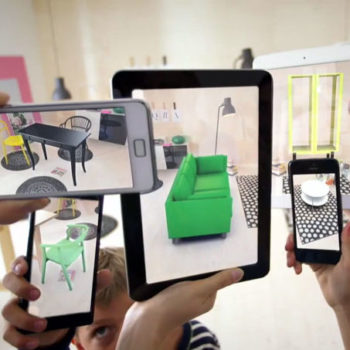Why AR Access Is Important for Retailers
by Romany Reagan on 1st May 2018 in News

Augmented reality (AR) is a relatively new phenomenon in the retail world, but some brands already realise how important it is to harness what the technology offers. In this piece for RetailTechNews, digital branding and ad-tech writer Kayla Matthews explains how companies that embrace AR reap the benefits in prolific ways, and there are various reasons why access to AR is crucial – not merely desirable – for those working in the retail sector.
Improved access increases the available ways to use AR
Compared to other types of technologies retailers frequently rely upon, AR is still emerging, and the number of tech businesses that specialise in it is relatively small in contrast to those offering strategies that have existed for decades.
However, due to the potential already shown by the technology, some companies treat it as their primary focus and cater to clients within and outside of the retail sector.
One of them is Blippar. That business assists some of the world’s top brands with implementing AR into their corporate strategies.
When the company worked with Uncle Ben’s to inform people about the rice they bought, Blippar brought AR to the food’s packaging. Consumers who buy the brand’s basmati rice in France can scan the back of the packages and learn about the food’s origins.
According to a recent survey that polled people about how sustainability affects their purchasing decisions, 53% did not know which companies shared their values. Thanks to the Blippar partnership, Uncle Ben’s is highlighting its sustainability principles while keeping its customers better informed.
As more companies join Blippar and encourage companies to use AR in innovative ways, the overall competition in the marketplace goes up among those entities that offer AR solutions. When that happens, companies realise that creativity and progressive thinking are essential for attracting customers and remaining profitable.
A lack of access could compromise the ability to influence consumers
Marketers know how important it is to favourably influence people who are in a decision-making mode. The ability to do so could make the difference between impressive profitability and substantial losses. Some innovative brands already target customers by sending promotional offers to their phones when they come close enough to the businesses offering them.
A newer trend involves using AR to drive traffic to retailers with AR-based geolocation features. Valpak, a company that provides local coupons, enhanced its app with an AR component that allows users to determine whether stores in the vicinity have enticing offers. They launch the AR component, hold their phones up and wait to view coupons appearing on the screens.
Assuming this way of offering coupons to consumers gains momentum, advertisers that do not have access to AR technologies will be at a significant disadvantage in engagement. Statistics published in a Google research article indicate 82% of shoppers use their phones to get details about products before buying them. Brands that follow the lead of Valpak’s AR usage could connect with customers better than ever through their phones.
AR technology facilitates corporate innovation
When ad-tech professionals don’t have access to the tools and financial resources that allow them to pursue AR, it could become difficult or impossible for them to innovate in ways that promote brand longevity. AR also facilitates companies’ ability to disrupt industries not characteristically connected to substantial innovation.
Concerning Capital One, for example, the company wants to disrupt the car-buying process with AR innovation. Data from the brand indicates 50% of people think researching a vehicle to buy is more important than choosing where to attend college or selecting a baby name.
So, Capital One built an AR feature allowing people to scan cars with their phones and instantly receive information about them. The real-time access to financing information, dealership locations, and more, could target many of the pain points customers typically experience when making vehicle purchases.
Access to AR gives marketers the freedom to anticipate global trends
Success in the marketing sector often requires taking a proactive stance and preparing for developments that align with worldwide market trends. Marketing professionals frequently study forecasts for their industries and use those projections to shape future intentions.
For example, from 2016 to 2022, analysts believe the beauty market around the world will achieve a 4.3% annual compound growth rate, topping out at almost USD$430bn (£311.9bn).
Marketers are wisely capitalising on the upward trend by appealing to customers and stimulating ongoing purchases. MAC Cosmetics tapped into AR and made a mirror that helps people see what makeup looks like on them before purchasing it, thereby eliminating buyers’ remorse.
Similarly, Benefit Cosmetics hopes to lend a helping hand to customers who intend to tame their eyebrows at home without relying on professional help. It has an AR feature that coaches people how to shape their brows to complement their faces.
Then, to motivate sales opportunities, Benefit showcases that tool on a page offering products to enhance eyebrows, such as specialised gels and pencils.
Consumer-facing cosmetic brands are part of only one of many sectors ripe for gearing up to make the most of increasing consumer interest. If companies can’t benefit from access to AR, their brands will likely get overtaken by those that are more prepared for what’s ahead.
These are some of the most compelling reasons AR accessibility must continue to increase for people in the world of retail. AR brings plentiful opportunities with it, all of which could boost brand prominence.This content was originally published in RetailTechNews.
Ad TechAugmented RealityUncategorized








Follow ExchangeWire